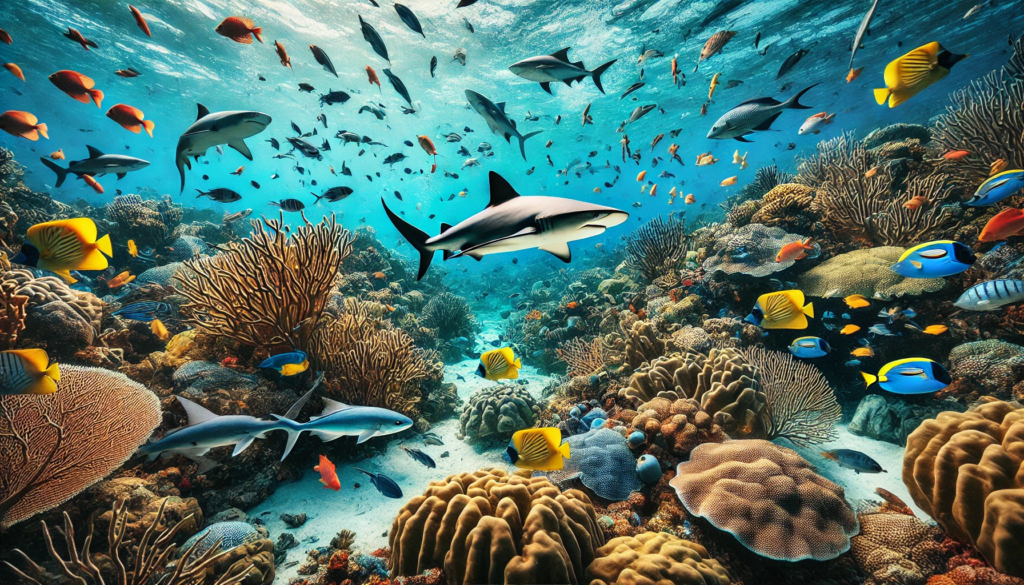The Caribbean Sea is a treasure trove of marine biodiversity, offering some of the most vibrant and diverse ecosystems on the planet. Its warm, clear waters are home to thousands of species of fish, coral, sharks, rays, and other marine organisms. These ecosystems are not only stunning in their beauty but also play crucial roles in supporting marine life, tourism, and the livelihoods of millions of people across the Caribbean islands.
The region’s coral reefs, mangroves, and seagrass beds create a complex network of habitats that sustain a wide variety of species. In this article, we’ll dive into the fascinating world of the Caribbean’s marine life, focusing on its colorful fish, predatory sharks, graceful rays, and the conservation efforts to protect these valuable ecosystems.
Coral Reefs: The Foundation of Marine Biodiversity
Coral reefs form the backbone of marine biodiversity in the Caribbean, serving as critical habitats for fish and other marine creatures. These underwater structures are formed by colonies of tiny coral polyps, which secrete calcium carbonate to build the hard skeletons that create the reef. Over thousands of years, these reefs have grown into massive, complex ecosystems that provide shelter, food, and breeding grounds for marine life.
Coral Reef Fish: A Kaleidoscope of Colors
The fish that inhabit Caribbean coral reefs are among the most colorful and diverse in the world. These fish come in all shapes and sizes, from tiny, darting species to large predators that patrol the reef.
Parrotfish
One of the most iconic reef fish in the Caribbean is the parrotfish. Known for their bright colors and beak-like mouths, parrotfish play a vital role in the health of coral reefs. They feed on algae that grow on the surface of coral, preventing the algae from smothering the reef. In doing so, they also help create the fine white sand that makes the Caribbean’s beaches so famous, as their digestion of coral produces sand.
There are several species of parrotfish in the Caribbean, including the rainbow parrotfish (Scarus guacamaia), which is the largest herbivorous fish in the region. These fish can be seen swimming in schools near the reef, their vibrant scales flashing in the sunlight.
Angelfish and Butterflyfish
Angelfish and butterflyfish are other common inhabitants of Caribbean coral reefs, known for their striking patterns and vibrant colors. The Queen Angelfish (Holacanthus ciliaris), with its electric blue and yellow scales, is one of the most easily recognizable species in the Caribbean.
These fish feed on a variety of invertebrates, such as sponges and small crustaceans, and they contribute to the delicate balance of the reef ecosystem. Their stunning appearance makes them a favorite among snorkelers and divers exploring the reefs.
Groupers and Snappers
Groupers and snappers are some of the larger fish species found around Caribbean coral reefs. These predatory fish play an important role in maintaining the balance of the ecosystem by keeping populations of smaller fish and invertebrates in check.
The Nassau grouper (Epinephelus striatus), once abundant in the Caribbean, has become increasingly rare due to overfishing. Efforts are now underway to protect this species through the establishment of marine protected areas (MPAs) and fishing regulations.
Sharks: Guardians of the Ocean
Sharks are some of the most misunderstood and feared creatures in the ocean, yet they are vital to maintaining healthy marine ecosystems. As apex predators, sharks help regulate fish populations and prevent any one species from dominating the ecosystem. The Caribbean is home to several species of sharks, many of which are key indicators of the health of marine environments.
Caribbean Reef Shark
The Caribbean reef shark (Carcharhinus perezi) is one of the most common shark species found in the region. These medium-sized sharks are typically seen patrolling coral reefs, where they feed on fish, octopuses, and crustaceans. While they are curious creatures, Caribbean reef sharks pose little threat to humans and are often seen by divers during reef explorations.
These sharks are an essential part of the coral reef ecosystem, helping to maintain the balance of species by preying on weaker or sick fish. However, like many other shark species, Caribbean reef sharks are threatened by overfishing, particularly for their fins, which are used in shark fin soup in some parts of the world.
Nurse Shark
Nurse sharks (Ginglymostoma cirratum) are another species commonly found in the Caribbean. Unlike many other sharks, nurse sharks are bottom-dwellers, spending much of their time resting on the ocean floor. They have a distinctive appearance, with broad, flat heads and barbels near their mouths that help them detect prey hidden in the sand.
These docile sharks are often spotted by divers, as they are slow-moving and tend to be more approachable than other shark species. Nurse sharks feed on small fish, crustaceans, and mollusks, using their strong jaws to crush hard-shelled prey.
Hammerhead Sharks
One of the most distinctive shark species in the Caribbean is the great hammerhead shark (Sphyrna mokarran). Known for their unique head shape, which gives them a wider field of vision, hammerhead sharks are formidable predators. They feed on a variety of prey, including fish, rays, and even other sharks.
Great hammerhead sharks are migratory and are occasionally seen in deeper waters around the Caribbean. These sharks are currently listed as endangered due to overfishing and the demand for shark fins. Their declining numbers highlight the need for stronger shark conservation measures in the region.
Rays: Graceful Creatures of the Ocean Floor
Rays are among the most graceful and fascinating creatures in the ocean. Closely related to sharks, rays have flat, wing-like bodies that allow them to glide effortlessly through the water or across the ocean floor. The Caribbean is home to several species of rays, including stingrays and eagle rays, which are often seen by divers and snorkelers in shallow coastal waters.
Southern Stingray
The southern stingray (Dasyatis americana) is one of the most commonly encountered ray species in the Caribbean. These rays are often found in sandy or muddy areas near coral reefs, where they use their flat bodies to burrow into the sediment and search for prey. Southern stingrays feed on small fish, crustaceans, and mollusks, which they uncover using their sensitive snouts.
Stingrays are generally shy and non-aggressive, but they do have a venomous spine at the base of their tail, which they use as a defense mechanism if threatened. One of the most popular destinations to observe stingrays in the Caribbean is Stingray City in the Cayman Islands, where visitors can swim with these gentle creatures in their natural habitat.
Spotted Eagle Ray
The spotted eagle ray (Aetobatus narinari) is one of the most striking rays in the Caribbean, easily recognized by its dark body covered in white spots. These rays are strong swimmers and can often be seen gracefully gliding through open water or near coral reefs. They are known for their long tails and “wings,” which can span up to 10 feet.
Spotted eagle rays feed on crustaceans and mollusks, using their powerful jaws to crush the shells of their prey. These rays are a favorite sight for divers, as they are known to perform impressive leaps out of the water when startled.
Conservation of Marine Biodiversity in the Caribbean
The rich marine biodiversity of the Caribbean is under increasing pressure from human activity. Coral reefs, which serve as the foundation of this biodiversity, are threatened by pollution, overfishing, and climate change. Rising ocean temperatures and acidification are causing coral bleaching, a phenomenon that weakens coral and makes it more susceptible to disease.
Coral Bleaching and Climate Change
Coral bleaching occurs when corals, stressed by rising ocean temperatures, expel the symbiotic algae (zooxanthellae) that live in their tissues. These algae provide the corals with energy through photosynthesis, and without them, the corals turn white and become vulnerable to starvation and disease. Widespread coral bleaching has been observed throughout the Caribbean, particularly during heatwaves caused by global climate change.
Protecting coral reefs from the impacts of climate change requires global action to reduce greenhouse gas emissions, but local efforts to reduce pollution and overfishing can also help. Marine protected areas (MPAs) are a critical tool in conserving coral reefs and the species that depend on them. By limiting human activity in these areas, MPAs allow ecosystems to recover and build resilience against future threats.
Marine Protected Areas (MPAs)
Marine protected areas have been established throughout the Caribbean to safeguard critical habitats for fish, sharks, rays, and other marine species. These protected areas restrict fishing, development, and other harmful activities, allowing marine ecosystems to thrive. Some of the most well-known MPAs in the Caribbean include the Bonaire National Marine Park, the Exuma Cays Land and Sea Park in the Bahamas, and the Hol Chan Marine Reserve in Belize.
In addition to protecting coral reefs, MPAs help preserve mangroves and seagrass beds, which serve as important nurseries for many species of fish and marine invertebrates. These ecosystems act as buffers against storms and help mitigate the effects of climate change by storing carbon.
Sustainable Fishing Practices
Overfishing is one of the most significant threats to marine biodiversity in the Caribbean. Many fish species, including groupers and snappers, have been heavily exploited for food, leading to population declines. Sustainable fishing practices, such as limiting catches, enforcing size limits, and protecting breeding grounds, are essential for ensuring the long-term health of fish populations.
Community-based conservation efforts, where local fishers work alongside conservation organizations, have shown success in promoting sustainable fishing practices. By empowering local communities to manage their marine resources, these initiatives create a sense of stewardship and ensure that future generations can continue to benefit from the ocean’s bounty.
Conclusion
The marine life of the Caribbean is a vibrant tapestry of species, from colorful coral reef fish and apex predators like sharks to the graceful rays gliding across the ocean floor. These ecosystems are not only beautiful but also vital to the health of the ocean and the livelihoods of people living in the region. However, they face growing threats from human activity and climate change, making conservation efforts more important than ever.
Through the establishment of marine protected areas, sustainable fishing practices, and global efforts to combat climate change, we can protect the Caribbean’s rich marine biodiversity and ensure that future generations can continue to marvel at the wonders of its underwater world.
FAQ
What are the most common fish species found in Caribbean coral reefs?
Some of the most common fish species in Caribbean coral reefs include parrotfish, angelfish, butterflyfish, groupers, and snappers. These species play vital roles in maintaining the health and balance of the reef ecosystem.
Are sharks dangerous to humans in the Caribbean?
Most sharks found in the Caribbean, such as the Caribbean reef shark and nurse shark, pose little threat to humans. Sharks are an important part of the marine ecosystem, and interactions with humans are generally non-aggressive.
What causes coral bleaching in the Caribbean?
Coral bleaching is primarily caused by rising ocean temperatures due to climate change. When corals are stressed by heat, they expel the symbiotic algae that provide them with nutrients, causing the coral to turn white and become more vulnerable to disease.
Where can I see stingrays in the Caribbean?
One of the best places to observe stingrays in the Caribbean is Stingray City in the Cayman Islands. Visitors can swim with southern stingrays in a shallow sandbar, providing a unique and memorable wildlife experience.
What is being done to protect sharks in the Caribbean?
Conservation efforts to protect sharks in the Caribbean include the establishment of marine protected areas, fishing regulations that prohibit shark finning, and public awareness campaigns that highlight the importance of sharks in maintaining healthy marine ecosystems.
How do marine protected areas (MPAs) benefit marine life?
Marine protected areas (MPAs) provide safe havens for marine species by limiting harmful activities such as fishing, pollution, and development. These areas allow ecosystems to recover and thrive, benefiting both marine life and the local communities that depend on them.

